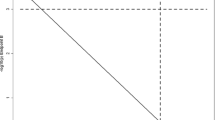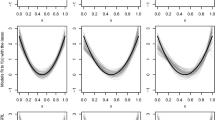Abstract
Purpose. This project was done to develop a mathematical model for optimizing composite predictors based on gene expression profiles from DNA arrays and proteomics.
Methods. The problem was amenable to a formulation and solution analogous to the portfolio optimization problem in mathematical finance: it requires the optimization of a quadratic function subject to linear constraints. The performance of the approach was compared to that of neighborhood analysis using a data set containing cDNA array-derived gene expression profiles from 14 multiple sclerosis patients receiving intramuscular inteferon-β1a.
Results. The Markowitz portfolio model predicts that the covariance between genes can be exploited to construct an efficient composite. The model predicts that a composite is not needed for maximizing the mean value of a treatment effect: only a single gene is needed, but the usefulness of the effect measure may be compromised by high variability. The model optimized the composite to yield the highest mean for a given level of variability or the least variability for a given mean level. The choices that meet this optimization criteria lie on a curve of composite mean vs. composite variability plot referred to as the “efficient frontier.” When a composite is constructed using the model, it outperforms the composite constructed using the neighborhood analysis method.
Conclusions. The Markowitz portfolio model may find potential applications in constructing composite biomarkers and in the pharmacogenomic modeling of treatment effects derived from gene expression endpoints.
Similar content being viewed by others
REFERENCES
M. K. Kerr, M. Martin, and G. A. Churchill. Analysis of variance for gene expression microarray data. J. Comput. Biol. 7:819–837 (2000).
M. K. Kerr and G. A. Churchill. Bootstrapping cluster analysis: assessing the reliability of conclusions from microarray experiments. Proc. Natl. Acad. Sci. USA 98:8961–8965 (2001).
M. K. Kerr and G. A. Churchill. Statistical design and the analysis of gene expression microarray data. Genet. Res. 77:123–128 (2001).
T. R. Golub, D. K. Slonim, P. Tamayo, C. Huard, M. Gaasenbeek, J. P. Mesirov, H. Coller, M. L. Loh, J. R. Downing, M. A. Caligiuri, C. D. Bloomfield, and E. S. Lander. Molecular classification of cancer: class discovery and class prediction by gene expression monitoring. Science 286:531–537 (1999).
P. Chomczynski and K. Mackey. Short technical reports. Modification of the TRI reagent procedure for isolation of RNA from polysaccharide-and proteoglycan-rich sources. Biotechniques 19:942–945 (1995).
W. P. Dunlop, J. M. Cortina, J. B. Vaslow, and M. J. Burke. Meta-analysis of experiments with matched groups or repeated measures designs. Psychol. Methods 1:170–177 (1996).
H. M. Markowitz. Portfolio Selection; Efficient Diversification of Investments. John Wiley & Sons, New York, 1959.
P. Wilmott. Derivatives: The Theory and Practice of Financial Engineering. John Wiley & Sons, New York, 1998.
Author information
Authors and Affiliations
Corresponding author
Rights and permissions
About this article
Cite this article
Ramanathan, M. A Stochastic Model for Optimizing Composite Predictors Based on Gene Expression Profiles. Pharm Res 20, 996–1000 (2003). https://doi.org/10.1023/A:1024450004215
Issue Date:
DOI: https://doi.org/10.1023/A:1024450004215




